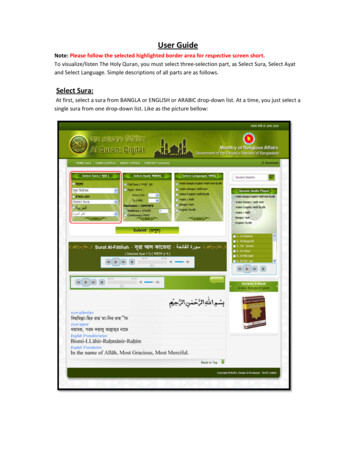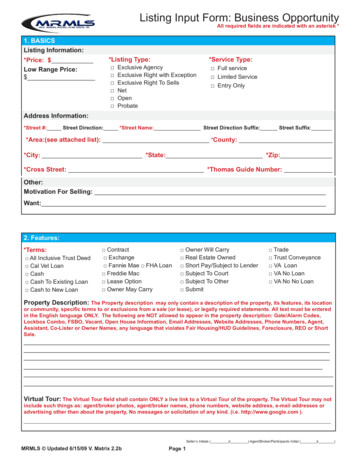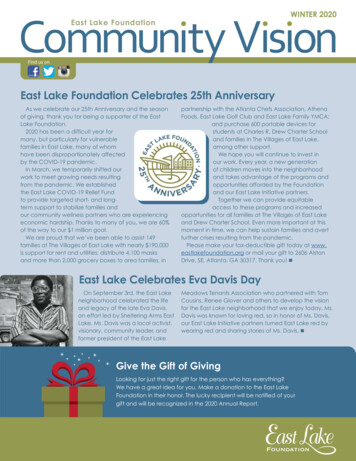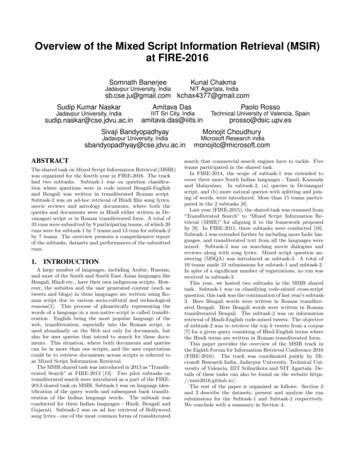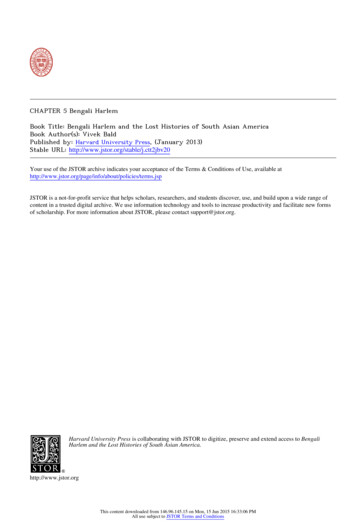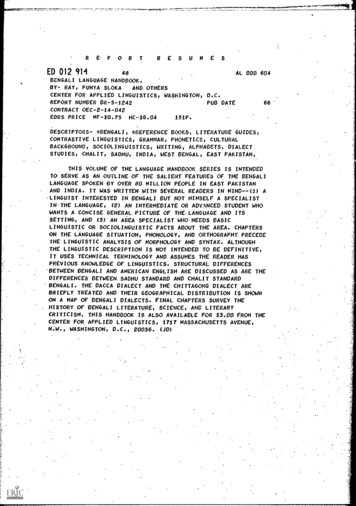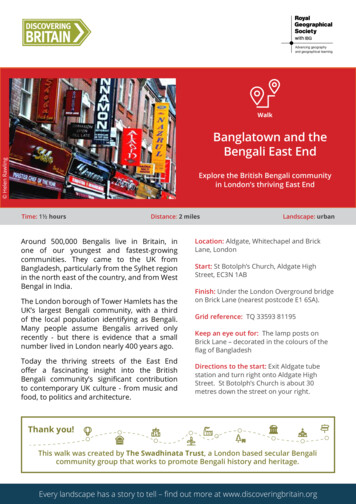
Transcription
Walk Helen RawlingBanglatown and theBengali East EndExplore the British Bengali communityin London’s thriving East EndTime: 1½ hours Distance: 2 milesAround 500,000 Bengalis live in Britain, inone of our youngest and fastest-growingcommunities. They came to the UK fromBangladesh, particularly from the Sylhet regionin the north east of the country, and from WestBengal in India.The London borough of Tower Hamlets has theUK’s largest Bengali community, with a thirdof the local population identifying as Bengali.Many people assume Bengalis arrived onlyrecently - but there is evidence that a smallnumber lived in London nearly 400 years ago.Today the thriving streets of the East Endoffer a fascinating insight into the BritishBengali community’s significant contributionto contemporary UK culture - from music andfood, to politics and architecture.Landscape: urbanLocation: Aldgate, Whitechapel and BrickLane, LondonStart: St Botolph’s Church, Aldgate HighStreet, EC3N 1ABFinish: Under the London Overground bridgeon Brick Lane (nearest postcode E1 6SA).Grid reference: TQ 33593 81195Keep an eye out for: The lamp posts onBrick Lane – decorated in the colours of theflag of BangladeshDirections to the start: Exit Aldgate tubestation and turn right onto Aldgate HighStreet. St Botolph’s Church is about 30metres down the street on your right.Thank you!This walk was created by The Swadhinata Trust, a London based secular Bengalicommunity group that works to promote Bengali history and heritage.Every landscape has a story to tell – find out more at www.discoveringbritain.org
Route and stopping points
01St Botolph’s Church without Aldgate02Devonshire Square, Cutler Street03No.13 Sandy’s Row04Calcutta House05Toynbee Hall06Altab Ali Park07Shahid Minar / Martyr’s Monument08Brick Lane09Janomot and former Café Naz10Brick Lane Mosque and Bangladesh Welfare Association11Kobi Nazrul Centre12Truman Brewery13Beneath the London Overground bridge
01 St Botolph’s Church without AldgateThe most common religions practiced by Bengalis are Islam, Hinduism and Buddhism. A Churchmay therefore seem an odd place to start our walk, but St Botolph’s holds an early clue toBengali presence in Britain.The church archives mention the burial here of “James, Indian servant of James Duppa Brewer”in 1618. James was a converted Indian Christian, who may have been a Bengali. This is our firsthint of how long people of Bengali origin have resided in Britain and the relationships they mayhave held with British people.The church we can see was built between 1741 and 1744 by George Dance, so it looks ratherdifferent to the one James might have known. St Botolph is the patron saint of travellers,however, so this is a rather fitting resting place for James, an early traveller from the Indiansubcontinent.With your back to the church, look diagonally right across Aldgate High Street to Jewry Street.Just 100 metres along this street is another site of hidden Bengali history.In the 1890s local benefactors Mr and Mrs Rogers set up an ayahs’ home and job centre on thecorner of Jewry and India Streets. Ayahs were Indian nannies, nursemaids and servants for thefamilies of colonial officers of the British Raj. These women came from Burma, China, and, ofcourse, Bengal in India.When the officers and their families returned to Britain, their ayahs often accompanied them.The Ayahs’ home provided support for these women. It helped them to find lodgings, work, ora passage home after they left their British employers. We will find out more about Britain’srelationship with Bengal over the next few stops.DirectionsFacing St Botolph’s, walk around to the left of the church through Dukes Place. Turnright into St Botolph Street, then almost immediately turn left into Houndsditch. Walk upHoundsditch and take the second right into Cutler Street.At the end of Cutler Street, cross the road and go through the grand gateway of DevonshireSquare, a luxury development of offices and restaurants. As you do so, look up at thebuildings on either side. Stop in the square.02 Devonshire Square, Cutler StreetNote the simple facades and large arched windows of these buildings. These luxury officeswere once the warehouses of the East India Company (EIC). The EIC was a British companyfounded in 1600 to trade with the East, South East Asia and India.The EIC was vitally important to the development of London’s East End and its links to Bengal.Over the years it developed into a huge corporation with its own military. The EIC effectivelybecame an aggressive colonial power and in 1757 seized control of Bengal, making many of itsofficials and stakeholders very wealthy.The EIC began by trading with Asia in 1600. Goods from EIC ships were unloaded at docks in the
Pool of London then brought here for storage The first building on this site stored raw silk andtextiles from Bengal, so it was named Bengal Warehouse. The building to our left is still calledThe Silk Store.With their fortress-like walls and fire-proof construction, these warehouses offered excellentprotection for the precious goods inside. Among other things, they stored spices, perfumes,pearls, tea, cotton, silks, indigo, ivory, and opium. But besides these goods, the EIC also broughthuman cargo - immigrant workers.They included lascars (Asian seamen) and then later ayahs (nannies), who arrived in Londonon EIC ships. The name ‘lascar’ was given to Asian sailors or militiamen employed on Europeanships from the 16th to the mid-20th century. It comes from the Persian word Lashkar meaning‘army’.Lascars were employed to provide manpower on ships returning from India. They were oftenpoorly treated and given the dirtiest and most dangerous jobs. Many lascars were Bengalis,who returned home on the next passage. Some jumped ship, however, or were abandonedhere without wages by unscrupulous employers.In 1782 the EIC recorded lascars arriving at their Leadenhall Street offices “reduced to greatdistress and applying to us for relief”. Initially the Company refused responsibility for thesemen, but from 1795 lascar hostels and seamen’s homes were set up in nearby Shoreditch,Shadwell and Wapping.By the early 19th century, over a 1,000 lascars had arrived in Britain through the Port of London.Thousands more came throughout the 18th century. Their lives were often poverty strickenand hard. In the winter of 1850 “some 40 sons of India” were found dead of cold and hunger onthe streets of London.In 1857 a missionary group founded the Society for the Protection of Asiatic Sailors and set up aStranger’s Home in Limehouse to help support the growing population. Standing outside theseformer warehouses, it is not hard to appreciate the very different lives lead by the lascars andother employees of the EIC.If you have time, walk straight ahead towards the new building with a clock mounted on itsfaçade. Just before the clock bear left (pass the Spice Building on your right) and walk towardsa small alleyway. Go through the alleyway into a courtyard with a glass roof. Continue straightahead and out through another alleyway opposite and into New Street beyond. Just on the leftyou will find a venue called the Old Bengal Bar serving Bloody Bengal and British Raj cocktailsin a rather unusual nod to the heritage of this place! Then head back through the two alleywaysto the clock.DirectionsWalk straight ahead towards the new building with a clock mounted on its façade. The clockcase is the original from the EIC warehouses. Turn to your right and take the exit down thenarrow alleyway onto Harrow Place. Turn left into Harrow Place and walk up it to MiddlesexStreet. Turn left into Middlesex Street and walk up it until it branches, with Middlesex Streetcontinuing to the left and Sandy’s Row heading off on the right. Walk along Sandy’s Rowuntil No. 13, the restaurant La Tagliata, on your right.
03 No.13 Sandy’s RowBetween 1945 and 1959 No.13 Sandy’s Row was the home of Ayub Ali Master. Ayub Ali was aninfluential Bengali man who ran a seamen’s café on nearby Commercial Road in the 1920s andthe Shah Jalal Coffee House on Commercial Street.We’ve stopped here to explore the role Bengalis played in British seafaring. By 1914 lascarsmade up 17% of mariners on British-registered ships. During the First World War sailors weredrafted into the Navy and Army, so lascars were employed on merchant and naval ships to aida shortage of manpower.After the war, many lascars were left without employment. In search of new work, some ofthem settled in London. Many entered the catering industry in the West End or the clothingindustry in the East End. Bengali lascars were drawn to the East End because there was alreadya Bengali presence here.These ex-seamen faced a number of struggles. Some had jumped ship and were wanted forbeing in breach of contract. Some had very little English, and others suffered racist abuse. AyubAli turned his home into a centre of support for these Bengali sailors. This included a lodginghouse, a travel agency and a job centre offering letter writing, form filling and educationalservices.As more Bengalis came to London, they were directed to Ayub Ali’s house as a first port of call.The lascars called him ‘Master’ because of his education and way with words. In 1943 AyubAli formalised the vital social welfare work he did with the lascars by setting up the IndianSeamen’s Welfare League.During the Second World War Bengali lascars also played an important role. They worked onmerchant ships, hospital ships and helped with the Dunkirk evacuation. Many of these seamenended up living in London afterwards. Overall though, the contribution of Bengali and Indianmen to both World Wars is often overlooked.Not far from here in Tower Hill, the Merchant Navy War Memorial lists seafarers killed in bothwars. It includes some of the 6,000 Indian seamen who died. Among them are many Bengalisurnames, such as Miah, Latif, Uddin, Choudhury, and Ali.DirectionsRetrace your steps down Sandy’s Row and almost immediately turn left into Frying PanAlley. Walk along the Alley and turn right into Bell Lane. Walk down Bell Lane until you meetWentworth Street. Turn left into Wentworth Street and then take the first right into OldCastle Street. Walk down Old Castle Street until you reach Calcutta House, part of LondonMetropolitan University. There is a covered walkway overhead and across the street onyour right is the former ‘Wash Houses’ building (Whitechapel’s public baths from 1846).04 Calcutta HouseThis building is currently part of London Metropolitan University, so why have we stoppedhere? The clue is in the name! Calcutta, now known as Kolkata, is the capital of the state of WestBengal.Calcutta was founded by Job Charnock, an English sailor and EIC administrator, who settled in a
Bengali village on the banks of the River Hooghly in 1687. Calcutta soon became an EIC tradingpost and fort. It then developed into a great port city, partly thanks to tea.This building, Calcutta House, was built as a tea warehouse for Brooke Bond in 1909, a companywho are still going strong today.The EIC shipped thousands of tons of tea to Britain. Britain’s tea was originally shipped fromChina but to break the Chinese monopoly on the trade, the EIC established its own plantations inIndia from the 1850s. Key tea estates were Assam in India and the hills of Sylhet in Bangladesh,as they had the right climate and soils. Both of these areas are in the east of the Indiansubcontinent, so Calcutta became the ideal port for shipping the tea to Britain.Tea was transported from the Sylhet plantations to Calcutta in small boats. Calcutta-based‘serangs’ (the headmen of Asian seamen crews) often recruited Sylheti sailors to work on theirships taking tea to London. Once in London, some Sylheti sailors jumped ship or lived heretemporarily while looking for passage back home.During the 20th century India was the world’s biggest tea producer (it is now the second-largestafter China). Before the commercial British plantations, tea was not a popular drink in India butmay have been used for medicinal purposes. It has grown in popularity since though - todayIndia is the largest consumer of tea worldwide!DirectionsRetrace your steps back under the covered walkway and turn immediately right into PomellWay. At the end of Pomell Way turn left into Commercial Street. Walk approx. 50 metresalong Commercial Street and turn right to look across the road at the redbrick building ofToynbee Hall (Note: in Summer 2018 there are renovation works taking place on the site you can still see the building peeping out behind the scaffolding).05 Toynbee HallThe gothic-style redbrick Toynbee Hall was founded by Samuel and Henrietta Barnett in 1884.Confronted by the poverty around them in the East End, they wanted a radical yet practicalsolution to help. So they set up Toynbee Hall as a centre for education and social action. Itaimed to bring together rich and poor to work together as an interdependent community.The building has impressive political connections. Between 1903 and 1905 the economistWilliam Beveridge worked here and began planning the principles of the modern welfare state.Beveridge was born in Bengal in 1879, the eldest son of a judge in the Indian Civil Service.His work here formed the basis for the establishment of the National Health Service and themodern benefits system.In 1910 Clement Attlee, MP for Limehouse and Labour Prime Minister (1945 to 1951), lived atToynbee Hall. More recently, Bengali residents continued the legacy of helping the East End’spoor communities. In the 1960s the Council of Citizens of Tower Hamlets organised Englishclasses for Bengali seamen and machinists here.The Hall still serves the Bengali community today by providing a meeting place, study centre,lecture hall and base for religious, political and cultural events, such as the Bengali LuncheonClub. Bengalis have been responsible for many innovations here. For example, Anis Rahman
helped develop women-only sessions at the Hall’s Free Legal Advice Centre and Abul Azadstarted ‘Surma’ which supports elderly Bengali people in the community.DirectionsWalk back down Commercial Street in the direction you have just come from and turn leftinto Whitechapel High Street. Before Whitechapel Gallery there is a small alleyway off tothe left called Gunthorpe Street. If you pop your head in here you can see a nice map andmural of the area, including Brick Lane.Continue along Whitechapel High Street past the Whitechapel Art Gallery. At the crossroadsof Whitechapel High Street, Osborn Street and White Church Lane walk into the greenspace of Altab Ali Park.06 Altab Ali ParkBefore 1998 this place was called St Mary’s Gardens Park after the 13th century church thatonce stood here. The church was painted white and gave the area its name – ‘White-chapel’. StMary’s was badly bombed during the Blitz and finally demolished after a lightning strike a fewyears later. Look for stone ‘remains’ in the grass which indicate the old church site.Now look at the ornate metal arch we passed under to enter the park. It was built incommemoration of a young Bengali man called Altab Ali. On the night of 4 May 1978 Ali waswalking home from his job as a leather garment worker on Hanbury Street. In an unprovokedracist attack he was fatally wounded on the edge of the park in nearby Adler Street.Sadly this was a time of overt racism in Britain, with many families living in fear of verbal andphysical abuse. The murder shocked the neighbourhood and roused the local community to act.Bengalis and other Asian youths were angry at the government’s failure to do anything aboutsuch attacks, at the levels of police racism and at the criminalisation of immigrant communities.In protest they carried Ali’s coffin all the way to Whitehall. They were joined by other anti-racistprotestors, forming a procession of over 7,000 people. It was a galvanising moment for Bengalicommunity organisations and had a real impact on the anti-racism movement in Britain.The Bengali youth movement, the Anti-Nazi League and Rock Against Racism were all born outof the events of 1978. The National Front, which had its headquarters not far from Brick Lane,was also driven out of the area. Altab Ali is remembered every year, although it was not until 20years later that this park was renamed to honour him.Local activist Ansar Ahmed Ullah said: “We weren’t able to transform anything overnight, but by the1990s the intensity and the violence had subsided I think we were able to change the mind-set of thesituation, in terms of how the police, councils and the government treated racism.”DirectionsNow walk to the far right hand corner of the park where you will find a red and whiteabstract monument.
07 Shahid Minar / Martyr’s MonumentThis is the Shahid Minar or ‘Martyr’s Monument’. It is a replica of a larger memorial in Dhaka,Bangladesh which commemorates the Language Martyrs. The Language Martyrs wereprotesters shot dead by police in 1952. The incident is seen as the start of the Independencemovement in Bangladesh.After the creation of Pakistan in 1947, questions arose over what the state language should be.Urdu was proposed. Students and intellectuals in East Pakistan, however, argued that Bengalimust be included as one of the state languages as it was widely spoken there.Discussions broke down and the West Pakistan-based government tried to instate Urdu alone.There were protests and strikes over the following years. On 21 February 1952 the police shotdead several protestors at Dhaka University. Days later a memorial was erected on the site.This monument in Altab Ali Park recalls it.In 1956 the government adopted both Urdu and Bengali as the state languages of Pakistan.While this helped matters, the East Pakistani population still felt under-represented by thegovernment. They demanded East Pakistan be given greater self-determination and be calledBangladesh. This culminated in the Bangladesh Liberation War of 1971, which ended withBangladesh becoming a sovereign nation.In 1999 the United Nations declared 21 February ‘World Mother Language Day’. In Bangladeshit is a public holiday. At midnight on 20 February (Shahid Dibosh), the Bengali community laywreathes in Altab Ali Park during a solemn ceremony remembering the Language Movement.Abdul Gaffar Choudhury, journalist and freeman of Tower Hamlets, wrote the well-knownMartyr’s Day song ‘Amar bhaier rokte rangano Ekushe February’, which is sung at the ceremony.This park is a very important site for British Bengalis. Jakia Chowdhury, who has lived andworked around Brick Lane since 1987, said of Shahid Minar: “I celebrate it every day, I keep theimportance. But I do also mark important events like Ekushe [21 February] and our IndependenceDay It’s my identity, it’s our identity. If I don’t mark that, I don’t know my roots.”DirectionsWalk around the park then exit the way you came in. Cross over Whitechapel High Streetat the crossing and walk up Osborn Street. Continue along Osborn Street until you seethe Sonali Bank on your left and metal archway over the street ahead. Stop somewherebetween the two.08 Brick LaneBrick Lane got its name in the 17th century as an area where clay was dug up for bricks. In1666, the Great Fire of London destroyed hundreds of wooden buildings and created a hugedemand for bricks to rebuild them. This street was a rutted clay track that became a source ofbrick making. The finished bricks were carried along here to Whitechapel. Architect ChristopherWren described Brick Lane as “unpassable by coach, adjoining to dirty lands of mean habitations.”Throughout the centuries, Brick Lane has been a hub for immigrants. In the 18th centurythousands of Huguenots, fleeing persecution in France, moved to the area. Many were skilledweavers and soon Brick Lane became a centre for the silk and garment businesses. In the next
century, Eastern European Jews settled here following pogroms in Russia. They slowly tookover the garment industries and also worked in the rag trade. Irish immigrants, fleeing famineand poverty in Ireland, worked here in the same trade.As Bengali seamen arrived in the area, they also found work in clothing and leather industries.Bengali immigration boomed in the mid-20th century. Following World War One, Britainrequired unskilled labour to rebuild the country. Britain appealed to former Commonwealthcountries for help. As a result, many from the Indian sub-continent came to Britain to work.With so many Bengalis living in the area, shops and cafes sprang up to cater for them. We’lltake a closer look at some at our next stop. Brick Lane gradually became the heart of theBengali community. Amjad Ali came to Britain in 1973 and grew up here: “Tower Hamlets meansBrick Lane. And everything starts from Brick Lane. You can say it is the capital city of the Bengalicommunity.”Shops along Brick Lane still sell fabrics, linings, buttons, machinery and other material for theclothing industry. For several decades, women’s garments sold by top retail chains were madehere, often as sub contracts in small workshops employing 5 to 8 men, or as piecework byBengali women working at home. This is no longer the case, and other Bengali businesses,particularly restaurants, have sprung up.On our left is Sonali bank. Sonali means ‘gold’ in Bengali - a fitting name for Bangladesh’s biggeststate bank. The bank enables local Bangladeshis to send money back to Bangladesh to supportfamily and friends. Money sent in this way is known as ‘remittances’. In 2015-16 863.28 millionwere sent in remittances from the UK to Bangladesh.Flows of remittances are changing as some people who live in Britain no longer have relativesliving in Bangladesh. Nonetheless, the bank is still an important part of the community andshows we are in a predominantly Bengali area.Now look ahead to the large metal archway over the street. Designed by Mina Thakur, it waserected in 1997 to mark the entrance to ‘Banglatown’. The crimson and green colours comefrom the flag of Bangladesh. Having contributed so much to the area, the Bengali communitycampaigned to get the arch installed as part of celebrating Bangladeshi culture around BrickLane.In the late 1990s Tower Hamlets Borough Council helped to fund and install the arch and rebrandBrick Lane as Banglatown to attract Londoners and tourists to this vibrant neighbourhood. Takea closer look around and you can spot some other additions to the streetscape. The lamppostsare also decorated in the colours of the Bangladesh flag and have recently been updated withillustrations referencing the history of the area. The street signs too now appear in both Englishand Bengali.DirectionsContinue along the street and under the arch along Brick Lane. Take the second right intoChicksand Street. Walk a little way up Chicksand Street and on the right you will see a signfor the offices of Janomot. Stop here.
09 Janomot and former Café NazWe are now outside the offices of Janomot, Britain’s longest-running Bengali weekly newspaper.Founded in 1969, originally the paper was written, prepared and printed all on this site. Todaythe journalists still work here while printing has moved off-site. Janomot is still Britain’s leadingBengali newspaper and emphasises just what a hub Brick Lane is for the community.Chicksand and its neighbouring streets is still very much a Bengali neighbourhood. The otherside of Brick Lane though has changed more over the last decade, with artists (including Gilbertand George) and young professionals buying houses and gentrifying the area. Some areconcerned that Bengali families are being priced out. Others have chosen to move further Eastto places like East Ham and Ilford to benefit from more space for their families.DirectionsWalk back down Chicksand Street and turn right into Brick Lane again. Look at the buildingon your right – No.46 Brick Lane, currently Belmonts Estate Agents.This building was once a cinema. It was originally built in 1936 as the Mayfair cinema and by the1960s had become Naz Cinema - a key hangout for Bengalis. On weekends, people travelledhere from all over Britain to catch the latest releases from the Indian film industry. It was evenvisited by Dilip Kumar, the Clark Gable of the Indian film, and his heroine Vaijanti Mala.The cinema also hosted meetings of young Bengalis and Asians keen to organise against andfight the racism they experienced in London and beyond. As recently as 1999 a car bombplanted by a neo-Nazi exploded outside Café Naz. Luckily no one was hurt and, on the whole,overt racism has been cleared from these streets.Next door to the former Café Naz stands Amar Gaon, one of many Bengali restaurants stillgoing strong. It sells an assortment of delicious Bangladeshi-British food, including fish curry.Curry is perhaps one of the things that Brick Lane is most famous for. Brick Lane has nearly 50Indian / Bengali restaurants and has been dubbed ‘Curry Capital’ of the UK.The first Indian curries sold in London were served in West End coffee houses during the 1770s.By 1960 there were 500 Indian restaurants in Britain. Now there are 10,000, employing 80,000people with a turnover of 2 billion. Most are owned and run by Bengalis. Curry houses servedishes cooked in a mix of British, Indian and Bengali styles.If you pop inside Amar Gaon, the counter on the right sells paan. Paan is a type of snack popularacross South Asia. It is made from betel nut, which comes from Betel Palm trees that grow in theregion. The nut is sliced thinly and wrapped in a paan leaf from the Betel Vine (Piper). It is thensmeared with a little lime, a pinch of tobacco and a sprinkle of aromatic spice - cardamom orturmeric. Paan is typically sucked after dinner as a digestive and stimulant, the lime producinga brick red juice that dyes the mouth.As we continue along Brick Lane keep an eye out for No. 55 Arzu Sweet Centre. There is a blueplaque on their wall marking this as the former residence of DJ Haroon Shamsheer of the dub/ dance collective Joi.Print media, films, food and music – all of these elements have made Brick Lane not just a keyhub for Bengalis, but a vibrant and innovative neighbourhood more widely. It is easy to see why
many people wish to celebrate this area as Britain’s Banglatown.DirectionsContinue down Brick Lane and stop by the distinctive silver minaret of the Brick LaneMosque10 Brick Lane Mosque and Bangladesh Welfare AssociationThe London Jamme Masjid, or Brick Lane Mosque, provides a fascinating reflection of thechanging waves of immigration that Brick Lane has played host to over the centuries. Today itis East London’s second mosque, where Muslims, including many Bengalis, pray to Allah. Themosque houses a religious school on the first floor and a large prayer hall on the ground floor.The building started life however in a very different vein. This was originally La Neuve Eglise(the New Church), built in 1743 by Huguenot refugees. The Huguenots were French Protestantswho towards the end of the 17th century faced persecution from Catholic royalty. Thousandsfled France and many settled in Spitalfields. In 1685 there were no Huguenot churches here - by1700 there were nine!In 1819 the building became a Methodist Church, and then in 1898 it was converted into anorthodox Jewish Synagogue. This reflected the influx of Eastern European Jews to the areain the early 19th century. By the second half of the 20th century many Jews had moved outto suburbs like Golders Green and Hendon in north London. So in 1976 the Synagogue wasconverted into a mosque for the growing Bengali Muslim community.Although many Bengali immigrants arrived before this time, often as seamen, a real influxcame in the mid-20th century. Like the Huguenots and Jews before them, many found work inthe textile industry, while others set up shops and restaurants.DirectionsTurn left into Fournier Street and the building next to the mosque with the blue front dooris No.39, the Bangladesh Welfare Association.Like the mosque, the Bangladesh Welfare Association had a Huguenot and Jewish past. Forexample its address, Fournier Street, is named after George Fournier, a man of Huguenotextraction. The building is now a centre for charitable work for the Bengali community.The Association was founded in 1952 as the Pakistan Welfare Association, to look after theincreasing number of Bengali seamen arriving in London and campaign for their rights. After theindependence of Bangladesh in 1971, the building was renamed ‘Shaheed Bhavan’ – ‘Martyr’sHouse’ and later the Bangladesh Welfare Association.This is the largest Bengali community organisation in the country, providing advice andinformation on welfare rights, housing, education and IT. In essence, it operates rather likeAyub Ali Master’s house did several decades before.
DirectionsReturn to Brick Lane and continue walking down it. [Note Taj Stores on the right justafter Princelet Street]. Turn left into Hanbury Street when it crosses Brick Lane. Just a fewmetres down the road you will find the Kobi Nazrul Centre on the left (the building with theburgundy coloured facade and gold lettering).11 Kobi Nazrul CentreThe Kobi Nazrul Centre is a Bengali arts and cultural centre founded in 1982 and named afterKazi Nazrul Islam. Kazi Nazrul Islam (1899-1976) is the national poet of Bangladesh. He was agreat humanist and wrote against sectarianism, slavery and colonialism, and in favour of socialjustice and women’s rights.In fact, he was known as the ‘rebel poet’ for his resistance to all forms of oppression. The Britishadministration in India jailed him during the Indian Independence struggle and banned someof his books. This was despite the fact that he had served in the British Army in the First WorldWar!Most of Kazi Nazrul Islam’s plays, poems, novels and songs were written between 1920 and1930. He drew on both Muslim and Hindu cultural traditions, so hi
At the end of Cutler Street, cross the road and go through the grand gateway of Devonshire Square, a luxury development of offices and restaurants. As you do so, look up at the buildings on either side. Stop in the square. Devonshire Square, Cutler Street Note the simple facades and large arched windows of these buildings. These luxury offices
